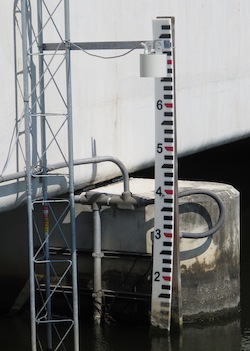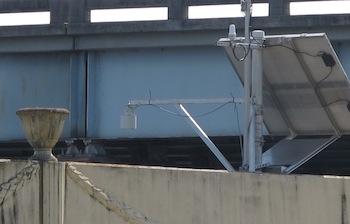The reason some critical water gauges in outfall canals failed during Hurricane Isaac is simple: The U.S. Army Corps of Engineers didn’t follow the installation instructions for the sensors.
After the 2011 hurricane season, the corps replaced the gauge sensors in the three outfall canals with ones that work by radar. The new sensors, which the corps said cost $2,000 each, should be more reliable because they sit above the water, not below.
But 16 of the 25 gauges in the canals and at the entrance of Bayou St. John went out at some point or gave bad readings at the height of the storm, according to hourly readings reviewed by The Lens. The gauges on the 17th Street Canal performed the worst; six of the eight sensors malfunctioned at some point on Aug. 29.
Isaac was the first full test of the new floodgates and pumping system installed after Hurricane Katrina. After the corps closes the floodgates at the entrances to the three outfall canals, it must pump rainwater out of the canals as quickly as the Sewerage & Water Board pumps it in. The gauges tell the corps if its pumps at the lake are keeping up with the city’s stations on the interior of the canals.
Although corps officials said the outages didn’t hinder their ability to monitor water levels in the canals, they did contribute to misinformation during the storm.
Corps personnel suspected two reasons for the outages: Isaac’s winds were too strong for the tall, three-legged metal frames on which many of the sensors are mounted. And some sensors were installed too low, leading to false readings when the water rose.

They were right about installing them too low. The gauges in the 17th Street and London Avenue canals appear to be lower than the manufacturer recommends.
Matt McBride, an engineer who has been tracking the improvements to the flood-control system on his blog, found the user manual for the Sutron brand radar sensors after The Lens published its story.
“The minimum distance for the sensor is 5 feet so make sure that the sensor is at least 5 feet above the highest stage that can be measured,” the manual states.
The corps’ has set the “maximum operating level” for the 17th Street Canal at 6.5 feet. That means the sensors would have to be at least 11.5 feet above the canal bed to reliably track the water level during a storm. Instead, they’re 8 or 9 feet.
Knowing that, it’s not surprising that two of the gauges in the 17th Street Canal maxed out during the storm, and another maxed out before going out, when the water rose to 6.5 feet.
The gauges on the London Avenue canal are mounted the same height, and in some cases even lower. With a maximum operating level of 5 feet in that canal, the sensors should be at least 10 feet. Water got to 4.4 feet there.

The sensors for the Orleans Avenue canal are better situated. They’re mounted at the top of the western wall. Not only is the wall more secure than the metal frames, it’s much higher.
The water at Orleans goes right to that wall, making such installation easier than on the other canals, where a grassy bank runs down to the water surface.
Asked about the installation problems, corps spokesman Ricky Boyett responded, “The Corps is currently doing a forensic analysis of Outfall Canal sensor performance and data collected during Hurricane Isaac. Among the things we are reviewing are sensor heights, measures to ensure stability in hurricane-force winds and additional technology that will provide redundancy at key points in the canals.”

